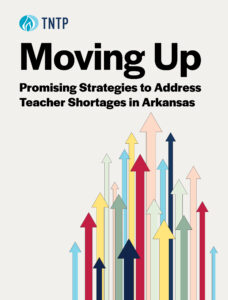***
In a school year filled with so many challenges for educators, students, and families, none has caused as much disruption as teacher shortages. Many schools across the country have faced a daily scramble to find enough teachers to stay open—one that the Omicron surge only magnified. This has huge implications for students: after all, students need access to diverse, effective educators to accelerate back to grade level after missing so much instructional time over the last two years.
But even though school staffing challenges have been in the news for months, there’s still very little information about the specific nature of these shortages—what is driving them, how long they might last, and the implications for system leaders and policymakers.
We decided to ask some of the people who lead staffing in school systems—the leaders facing these challenges every day—for their perspective. What we heard from 21 of them—representing 12 states and 630,000 students—was deeply concerning. An overwhelming majority of these leaders told us not only that staffing has been particularly challenging this year, but that they see warning signs it won’t get better anytime soon. Their responses suggest that without significant changes to make teaching a more attractive and sustainable career, the current crisis may become the new normal. We hope leaders inside and outside education will take these perspectives into account as they work to ensure schools and students have the effective, diverse teachers they need.
Methodology
We sent a survey to school system leaders around the country who manage staffing (Chief Talent Officers or similar titles) and heard back from 21 of them. These 21 school systems represent 12 states and are responsible for educating over 630,000 students; cumulatively, 74% of those students are students of color, and over 60% are economically disadvantaged.
The exact contours of teacher shortages tend to vary widely from district to district, so we’re not suggesting this is a representative sample of the country. But we were struck by the consistency of the answers from systems who responded and felt the results were important to share.
Findings
Teacher Hiring—for Both Full-Time Teachers and Substitutes—Has Gotten Much More Difficult
An overwhelming percentage of the system leaders we surveyed reported that hiring is indeed more challenging than in previous years:
- 100% said it was harder to hire substitute teachers than in previous years.
- 86% said it was harder to hire classroom teachers than in previous years.
- 76% reported fewer applications for their vacancies than in previous years.
Leaders attributed this to both teaching becoming a more difficult—and thus less attractive—job, as well as rising wages in the private sector. As one leader put it, “Jobs that were already hard have become harder, parents have less patience than ever, and the private sector raises wages for jobs that attract candidates who would otherwise become para[professional]s, nutrition workers, drivers, and subs.” In other words, school employees are simultaneously being pushed out by the working conditions and pulled away by the attractiveness of other industries.
Working Conditions Have Hurt Teacher Retention
The leaders we surveyed have struggled with retention as well. 76% said they have seen more teacher resignations than previous years. 71% reported more day-to-day teacher absences.
Leaders emphasized how resignations and absences hurt both students and teachers. At a basic level, when students don’t have consistency in their teachers, the quality of instruction decreases. And when school leaders have to use other adults in the building to cover classes, there are negative cascading effects. For example, if paraeducators and other aides cover classes, the students they typically work with miss out on crucial supports. And when the school leaders themselves have to step in front of classrooms, they can’t focus on strategic planning, instructional coaching, or other priorities.
Perhaps most troubling, resignations and absences make it tougher on the teachers who remain. As one leader put it, “Adults who are working incredibly hard are burning out and not able to provide their best. Adults who are covering classrooms and unable to be prepared for their own classroom instruction—taking more work home than they typically would.”
It’s worth noting that there isn’t a perfect data set on teacher resignations nationwide—and resignations may be a lagging indicator anyway—so we do not have evidence this is a national trend. But given how difficult this year has been for educators, it is important to monitor whether resignations increase this spring and summer.
Teacher Recruitment and Retention May Remain Difficult Without Big Changes
It is tempting to assume that this year’s school staffing challenges are primarily driven by the COVID-19 pandemic—and so should soon dissipate along with the virus. But when we asked leaders whether hiring would return to normal next year, 16 of the 18 who responded to the question—89%—said “no.” They believe that their hiring challenges are due not just to the pandemic, but to fundamentals of the teaching profession that don’t work in the current economy. Teachers aren’t paid enough, are asked to do too much amid difficult working conditions, and aren’t valued and respected—and prospective teachers are noticing. As one leader told us, “I think it will take years of salary increases, investments in building culture and support staff, and slow word of mouth to build up traditional and non-traditional pipelines again.” This is only exacerbated by the increase in the number of posted teaching positions and the decrease in teacher preparation program enrollment.
Several leaders suggested that increasing flexibility—as has happened in many other professions—could improve teacher retention. One leader put out a broad call to consider this: “Legislators, communities, families and districts should explore the instructional model (at home, face-to-face, hybrid, etc.) that provides flexibility for families and employees to help mitigate the stressors that are causing retention efforts to fail.” Others mentioned the option of having teachers who worked part-time.
***
There are still a lot of questions to answer about the causes and consequences of school staffing challenges this year—and we’ll be releasing more research on the topic in the months ahead. But the perspectives of these 21 Chief Talent Officers send a clear message. School systems, policymakers, teacher preparation programs, funders, and other education leaders should come together to not merely work toward a return to “normal,” but to address the systemic issues preventing too many schools from finding and retaining the teachers their students need. If we’re serious about ensuring that all students have access to diverse, effective teachers, there is no other option.








